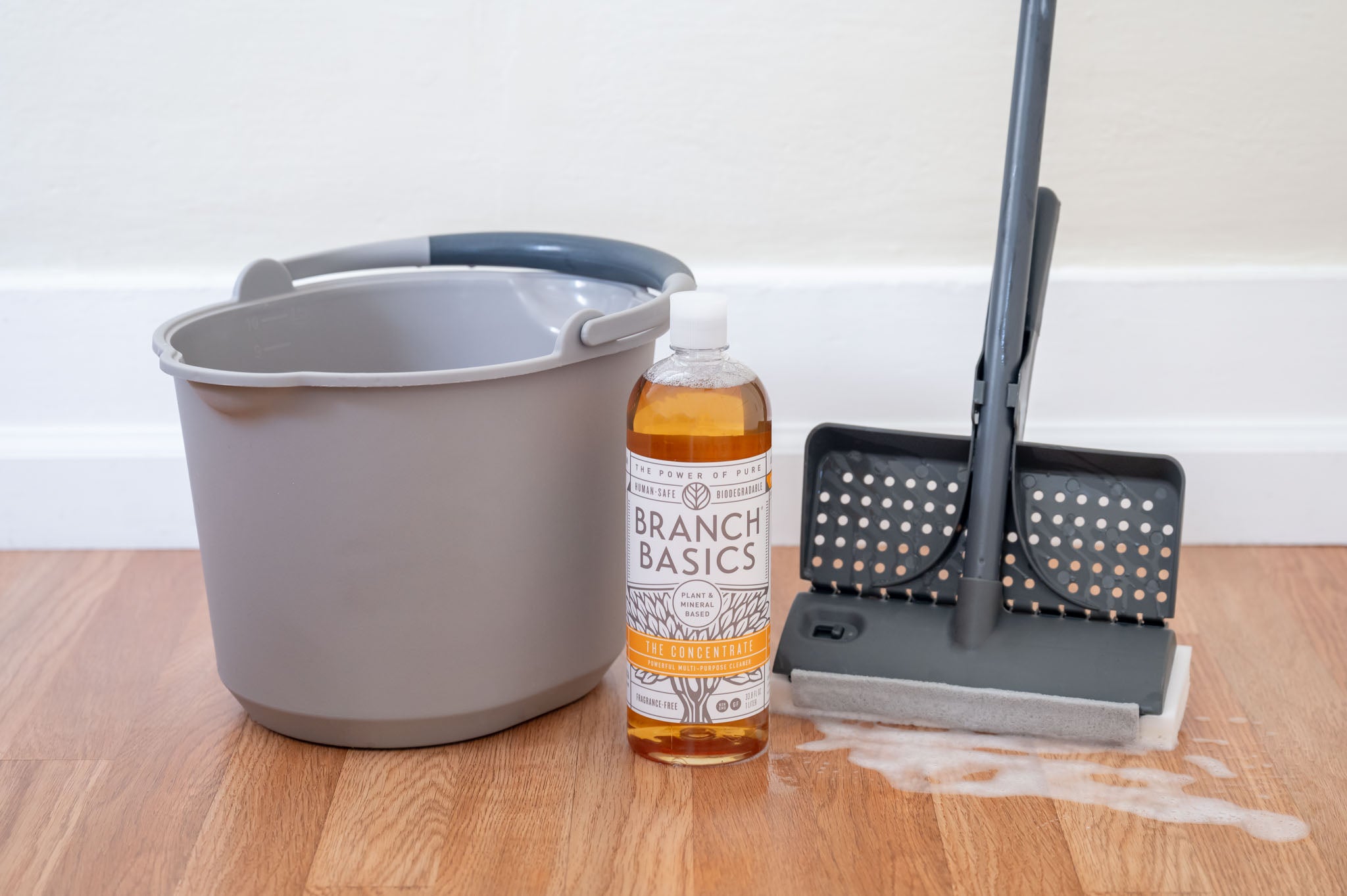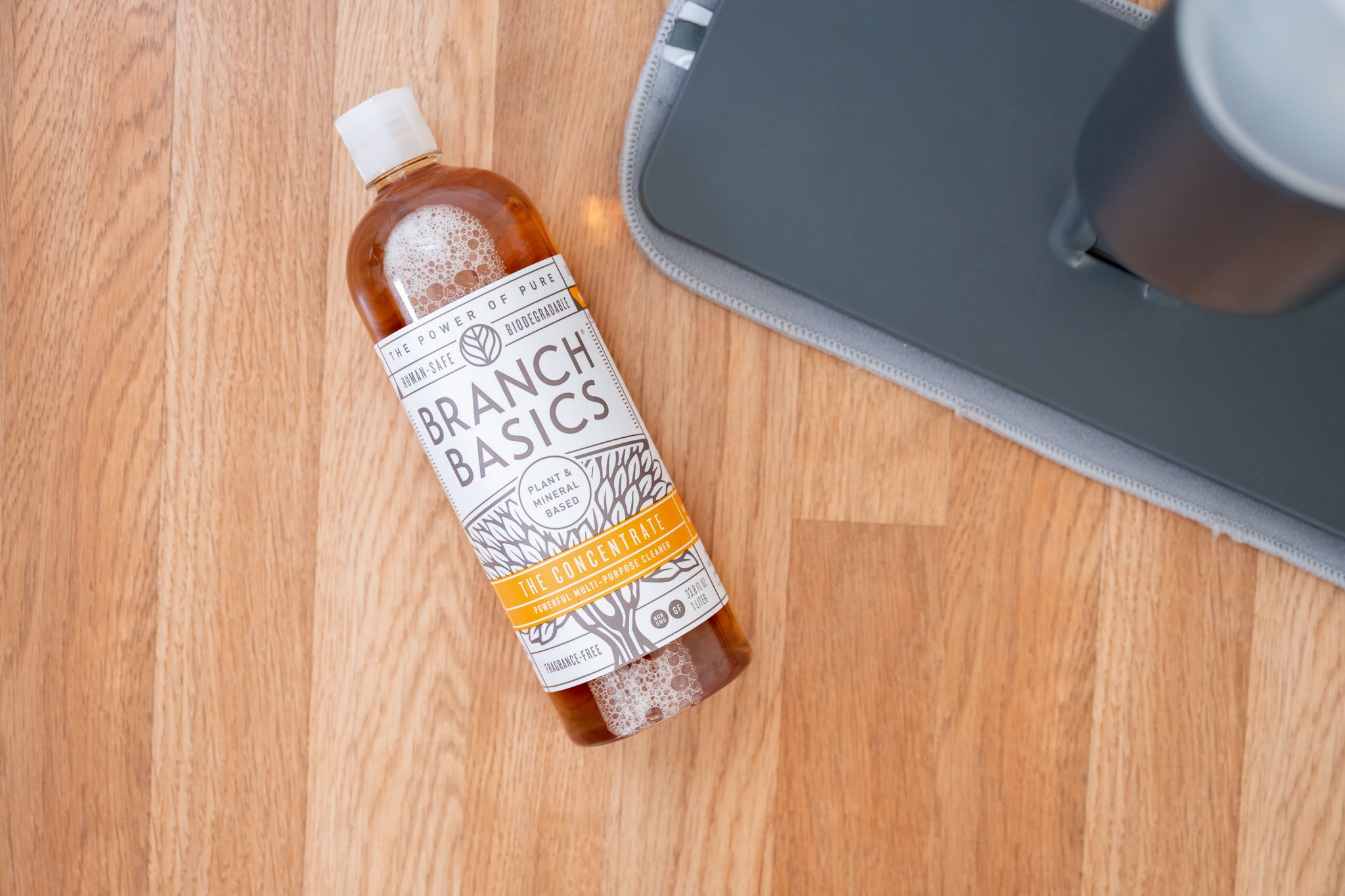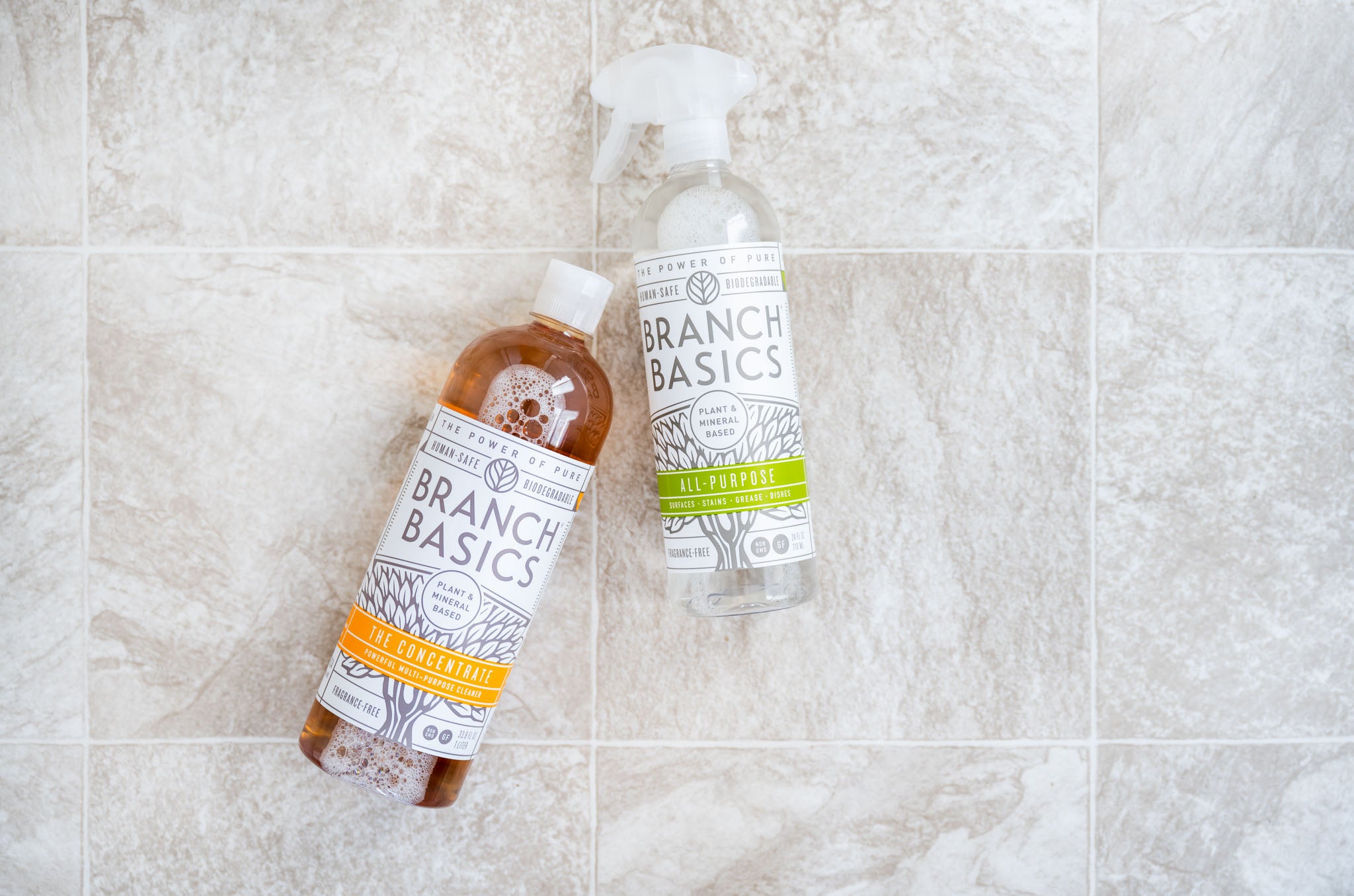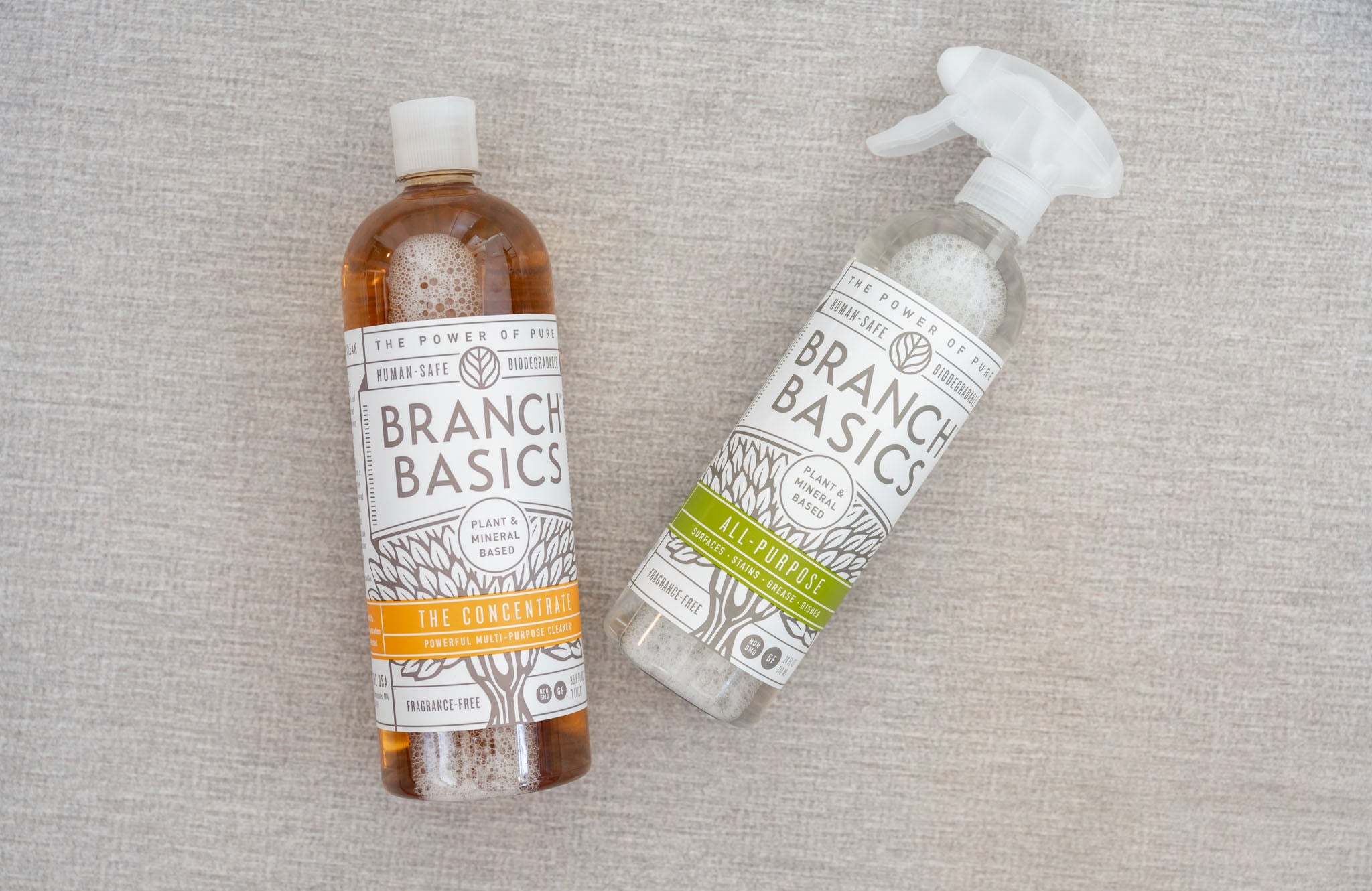Our Ultimate Guide to Synthetic Chemical-Free Floor Cleaning
By Marilee Nelson |

Your shoes carry you across parking lots, through gym locker rooms, and into bathroom stalls, where they pick up E. coli (which can cause intestinal and urinary tract infections), Klebsiella (pneumonia bacteria), and Serratia ficaria (a respiratory tract infection bacteria).1
In addition to bacteria, your shoes likely carry a healthy mix of asphalt, pesticides, herbicides, and other harmful chemicals --- not to mention dirt. If you wear shoes inside your home, you track these chemicals all across your home as well.
Of all the floor types, carpeted floors are the hardest to get truly clean
On average, every square inch of carpet is home to about 200,000 bacteria, which is 4,000 times more bacteria than you might find on your toilet seat.2
And forget the 5-Second-Rule, the bacteria on your floor may live for up to four weeks in the carpet!3
While these bacteria sound scary, the truth is that conventional cleaning products, particularly carpet cleaners, are also harmful to your health.
Common floor cleaning products include perchloroethylene (a dry cleaning chemical that causes nausea, dizziness, and fatigue) and even naphthalene (a carcinogen manufactured from coal tar that affects the central nervous system).4
Learn more in: 5 Carpet Cleaner Alternatives That Actually Work
Whether you have small children, pets, or live alone, you likely spend some time on the floor each day. For the sake of your health and indoor air quality, it’s important for that floor to be clean.
All that said, there is no reason to become discouraged about cleaning your floors!
We’ll walk you through quick and simple steps that are easy (and safe) enough for a child to do.
So skip the fragranced sprays, polishes, and harmful chemicals. It’s easier than you think to keep your floors clean and to use human-safe, plant- and mineral-based, and environmentally-friendly cleaning products to do it.
Tools for Clean and Healthy Floors
- From the Branch Basics Starter Kit:
- Vacuum (HEPA sealed systems are recommend)
- Scrub Brush
- Microfiber Cloths*
- Clean, Dry Towel
Optional Additional Tools:
- Branch Basics Oxygen Boost (for tile grout)
- Mop (for hard surface floors - choose one)
- reusable microfiber mops*
- unscented refillable microfiber mops (Swiffer is one brand)*
- spray mop
- steam mop like the Hoover Steam Mop
- classic cotton mop or sponge mop
*Microfiber mops and cloths are highly recommended because they remove 99% of bacteria with just water!
To get started, check out the Branch Basics guide to essential cleaning tools.
How To: Safe & Natural Everyday Floor Cleaning
Always clean from top-to-bottom, in-to-out of a room. Start in the farthest corner (least trafficked) and clean any cobwebs or dust you see on the ceiling or on surfaces, like walls and tables.- Sweep or vacuum up any loose dirt in the room.
- Spray any grease, grime, or dirt spots directly with Branch Basics and wipe clean with a rag. If needed, after spraying the spot, use a scrub brush to loosen any caked-on materials.
- Use one of the 3 Easy Floor Cleaning Methods from below to clean the floor.
Three Easy and Safe Floor Cleaning Methods
1. Spray-as-you-go method (easiest)

1. Use a spray bottle to spray down your floor.
An All-Purpose spray bottle works great for ceramic and porcelain tile and natural stone floors, while a more diluted version is better for vinyl and linoleum floors.
2. With a clean, damp mop, rag, or dish towel, wipe each area as you spray it until you’ve cleaned the entire room. Allow to dry or follow with a dry towel to soak up extra moisture.
Note: If you are cleaning hardwood floors, we recommend spraying the mop, towel, or rag and then wiping, rather than spraying the floor itself (see additional hardwood floor instructions below).
We especially love this cute and easy tip from Wellness Mama on including your kids in floor-cleaning:
“Our home could be re-named the land of mismatched socks. I don’t know how, but somehow my children manage to lose, ruin or hide socks.
My ever-growing mismatched sock bin was frustrating me...until we figured out we could mop the floor with them...I just give each child a spray bottle of diluted Branch Basics cleaner, let them all put on several layers of mismatched socks and ‘skate’ on the floor.
They spray a spot and then glide over it to clean it. As socks get dirty, they just peel them off to get to a clean layer.”
Related Reading: How to Clean Floor Tile Naturally
2. Bucket & Mop method (tried and true)

1. Fill a bucket with a mixture of Branch Basics Concentrate and water (approximately 1/2 - 1 teaspoon per 2 cups of water works for most tile, vinyl, cork floors). Dilute more if the floor is sticky when dry.
2. Wet the mop with the soapy water and wring out well. Mop the floor, then allow to air-dry.
If you are cleaning a hardwood floor, increase the dilution to 1/8 - 1/4 teaspoon per 2 cups of water and make sure to just lightly dampen the mop so that it does not leave excess moisture on the floor.
3. Wipe dry any wet spots.
3. Steam or Spray Mop method (most consistent clean)

If you prefer using a special mop to clean your floors, we recommend the a spray mop or Hoover (steam) mops. Follow the manufacturer’s instructions for using these mops to clean the floor.
As opposed to other brands, these allow you to use your own safe and natural cleaning products in the soap cartridges. They’re a tidy, economical, and sustainable way to clean your floor (no need for batteries, disposable pads or harmful chemical fragrances).
If you do use one of these mops, note that the plastics used to make them are high in VOCs, which outgas into your air over time.
If you purchase a new product like one of these mops, we recommend speeding up the off-gassing process by using the sunning method before using to leave the airborne VOCs outside.
Tip: Instead of their soap solution, we recommend trying a mixture of 1 teaspoon of Branch Basics Concentrate to each cup of distilled water you use for the cartridges.
How To: Safe & Natural Thorough Floor Cleaning
There are times you'll need to thoroughly clean your floor. For those times, there are a few more steps, but the process is still simple and straightforward, leaving you with a squeaky clean floor free from synthetic chemical residues.
1. If you have a sealed system HEPA vacuum, start with a thorough vacuuming of the floors and baseboards. Removing dust and dirt with a vacuum is especially important for wood floors because the dirt can scratch the floor when cleaning.
If you don't have a sealed HEPA vacuum, no worries, use a reusable microfiber mop or a refillable Swiffer microfiber mop (use only unscented refills) to grab up and remove the dust.
2. After vacuuming, use a microfiber dust cloth with Branch Basics All-Purpose spray to wipe down the baseboards.
This will remove any extra dust, dirt and visible grime. This step will also break down any residual pesticides that may have been sprayed on the baseboards. Test on small area first, especially if the baseboards are coated in oil-based paint.
3. Spot-treat any greasy or particularly dirty areas of the floor.
Our All-Purpose spray is perfect for spot-treatment. If needed, scrub the area with a scrub brush until the spot is gone.
Specific Instructions for Different Floor Types:
Hardwood

Hardwood floors can be tricky because many cleaners are too strong for their protective finish.
But actually, you do not need much soap to get a hardwood floor clean; a dilution ratio of 1/8 - 1/4 teaspoon of cleaning concentrate per 2 cups of distilled water works for most synthetic wood floor finishes.
Always test the diluted soap solution in a hidden area before cleaning entire floor to make sure it doesn't affect the finish on the floor.* When in doubt, make it more diluted - use less soap and a higher ratio of water.
Instead of a mop and bucket method, we recommend spraying the soap mixture onto a slightly damp mop, rather directly on the floor.
If the floor looks wet (not damp) after cleaning, follow up with a dish towel to dry off any wet spots as leaving a hardwood floor wet can damage the floor.
Tip: If you have any small scratches in your floor, here’s a simple trick to disguise them: Using a crayon (similar to the color of the floor), rub the scratch to fill the gap. Turn a hair dryer on high and heat the area until the crayon melts smoothly into the scratch. To finish, buff with a soft cloth.
*Hardwood floors with a natural oil or wax finish should only be cleaned with the manufacturer's recommended cleaner. Branch Basics is likely to remove natural finishes. Branch Basics works well on most urethane/acrylic/polyurethane/UV cured synthetic floor finishes.
Vinyl & Linoleum

To protect the integrity of your vinyl or linoleum floor, we recommend a more diluted version of our soap.
Try a mixture of 1/2 - 1 teaspoon of the Concentrate per 2 cups of water. If floor is sticky when dried, dilute more. For tiled linoleum floors, use a soft brush to agitate the grout.
Be sure to never leave any standing water on a linoleum floor, as it will warp the floor, destroy the glue, and cause it to look dingy, even when clean. When in doubt, buff dry with a clean towel after you’ve finished washing the floor.
Tile

Ceramic and porcelain tile floors, as well as natural stone floors, are easy to clean with Branch Basics.
Use a mixture of 1/2 - 1 teaspoon of the Concentrate per 2 cups of water. If the floor is sticky when dried, dilute more.
Spray stains with the All-Purpose bottle directly and wipe clean - no need to rinse.
Tile floors often look dirtier than they are because the grout, which is porous, easily absorbs stains and grease, and quickly darkens.
To clean the grout, spray with All-Purpose and let sit for 5 minutes. Use a soft brush to agitate, then wipe clean.
If the grout is particularly grimey, sprinkle Branch Basics Oxygen Boost onto the area and then spray liberally with All-Purpose.
Alternatively, you can mix 1 scoop of Oxygen Boost with 1 tablespoon of warm water (add more water if needed). Let sit for 15 minutes to an hour (make sure it stays damp), then scrub with a brush. Wipe clean. Repeat as needed.
Tiles that have a hazy appearance, even after cleaning, probably have a soapy residue or even a hard water residue (if tap water was used).
If this is a problem, use slightly less soap and be sure to mix with distilled water for the best results. Buff the floor dry with a clean cloth for a good shine!
Carpet

Always test Branch Basics soap in a hidden area first for colorfastness and compatibility.
To remove a stain, spray All-Purpose directly on the spot and allow to sit for 1-5 minutes. Agitate the area with a brush or rag until the stain disappears.
If you want to use a carpet cleaning machine, swap out the conventional carpet cleaning soap with Branch Basics Concentrate in dilution of 1/2 teaspoon Concentrate per cup of distilled water.
Bricks & Driveway

To remove oil stains from driveways or garage floors, spray first with water, then spray with All-Purpose.
Let sit for 5-10 minutes to let the surfactants dislodge, lift up, and break up the grease.
Then rub briskly with a stiff brush, rinse, and repeat if necessary.
For bricks, wet the area with water, then spray with All-Purpose, scrub with a brush, and rinse.
Easy, Everyday Tips for Keeping Floors Clean
Use Doormats & Go Shoe-Free
Using a doormat outside all your entry doors will help keep dirt out of your home and will keep your space visibly cleaner.
Even with a doormat, shoes track in not only visible dirt and mud, but also invisible chemicals, pesticides, herbicides, and more. In fact, the chemicals in asphalt stick to your shoes, which can yellow your floors over time if you wear them inside.
Rather than walking through your home in shoes covered in dirt, dust, and harmful chemicals, remove them at the doormat or just inside the door and go barefoot or wear slippers inside. Your floors will look cleaner and your indoor air will be cleaner too.
Tip: Make a shoe-removal area by your door and keep it stocked with cozy socks or slippers, particularly in the winter time.
Vacuum Regularly
Regular vacuuming can keep your floors extremely clean and is preferable to sweeping because it helps remove dust from your indoor air rather than stirring it up. A quality, sealed-system HEPA vacuum is the best option, particularly if anyone in your home has allergies, asthma, or other environmental sensitivities.
If you have hardwood floors, avoid using a beater bar attachment, as this can scratch your wood floor finish. If you don't have a vacuum, the use a microfiber mop on hard surface floors is helpful.
Related read: Home Cleaning Guide For Allergy Sufferers
Check Your Air Filters
Your air conditioning systems use filters to keep your indoor air relatively dust-free and to maintain the integrity of the cooling and heating unit. This also helps keep your floors and other surfaces clean by reducing dust in the air.
A good way to extend the length of time between floor cleaning is to make sure to change your filters regularly. Install the best grade filters you can reasonably afford and change them at the recommended intervals, or sooner if needed. This will keep the proper amount of air moving and help keep the ductwork and fan blades cleaner.
One of the healthiest options are Filtrete filters (by 3M). All Filtrete filters reduce particulates in your air and some reduce both particulates and odors.
Clean with Distilled Water
When cleaning a floor, the best way to avoid streaks and mineral deposits is to use distilled water for cleaning. This includes the water you use to mix your Branch Basics bottles, as distilled water does not contain the minerals and other particles that tap water does.
Overall, using distilled water will give you the best results for cleaning, no matter which surface you are cleaning, floors included.
You can have clean floors without using harsh chemicals
Learn more about how to clean your floors with Branch Basics to ditch the synthetic chemicals.
Try the Trial Kit to get started, and check out the Branch Basics Travel Kit for cleaning on the go.

Marilee Nelson
Marilee Nelson is an Environmental Toxins expert who has spent nearly 30 years advocating for the chemically-sensitive and chronically-ill. She is a Board Certified Nutritionist, Certified Bau-Biologist and Bau-Biology Inspector and specializes in Food As Medicine. She has helped thousands of families and individuals identify, heal and recover from toxic exposures and is on a mission to revolutionize the way American families view their health.








